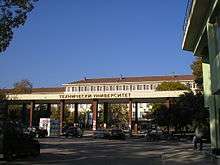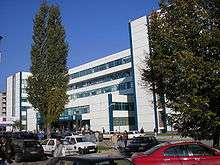Technical University, Sofia
The Technical University (Bulgarian: Технически университет), based in Sofia, is the largest technical university in Bulgaria.
Технически университет - София | |
 | |
| Type | Public |
|---|---|
| Established | 15 October 1945 |
| Rector | Ivan Kralov |
| Undergraduates | 7952 (April 2020)[1] |
| Postgraduates | 1679 (April 2020) |
| Location | , |
| Website | www |
Founded on 15 October 1945 as part of the Higher Technical School (later renamed to State Polytechnic), it is an independent institution since 1953, when the Polytechnic was divided into four separate technical institutes. It has had its present name and university status since 21 July 1995 and has 14 main faculties based in Sofia, Plovdiv and Sliven, as well as 3 additional ones with education only in foreign languages — German, English and French.
History
With Decree No 237, published in the State Gazette issue 248 from 24.10.1945, of the National Assembly of Bulgaria, a school called "State Polytechnic" is created with Mechanical engineering faculty with four divisions - mechanical engineering, electrical engineering and mining and geology.
In 1953, the State Polytechnic was split into four new higher institutes, one of which was the Institute of Mechanical and Electrical Engineering. It had two faculties - one of mechanical and one of electrical engineering.
Two years later, in 1955, the word "Higher" was added to the name.
In 1959, a faculty of Transport and Communications was formed[2] which four years later (in 1963) was split into Faculty of Transport (existing until today) and Faculty of Radio Electronics.
The last was split into three in 1987[3] - Faculty of Electronic Engineering and Technology, Faculty of Telecommunications and Faculty of Computer Systems and Control all existing today. Some of the staff of the newly formed Faculty of Computer Systems and Control used to previously work in the Faculty of Automatics, which was separated from the faculty of Electrical Engineering in 1974.
The Faculty of Mechanical Engineering was only split once, in 1963,[4] when two new faculties - of Machine Technology and of Power Engineering and Power Machines, were formed from it.
In 1991, the faculty of Management was formed.
Since 1991 the Higher Institute of Mechanical and Electrical Engineering was renametd to Technical University of Sofia.
The Technical University of Sofia is one of the eight holders of the European University of Technology, EUt+[5], with the Riga Technical University (Latvia), the Cyprus University of Technology (Cyprus), the Hochschule Darmstadt, University of Applied Sciences (Germany), the Technological University Dublin (Ireland), the Polytechnic University of Cartagena (Spain), the University of Technology of Troyes (France), the Technological University Dublin (Ireland) and the Technical University of Cluj-Napoca (Romania).
The European University of Technology, EUt+ is the result of the alliance of eight European partners who share in common the "Think Human First" vision towards a human-centred approach to technology and the ambition to establish a new type of institution on a confederal basis.
Through EUt+, the partners are committed to creating a sustainable future for students and learners in European countries, for the staff of each of the institutions and for the territories and regions where each campus is anchored.
Campuses
The Technical University of Sofia consists of 5 campuses: Sofia, Plovdiv, Sliven, Botevgrad, Kazanlak.
The Central Campus in Sofia includes 14 buildings.


Building 1 used to be army barracks and now houses the administration of the university as well as the administration, the offices of scientists and most laboratories of:
- The Faculty of Electronics Engineering and Technology
- The Faculty of Telecommunications
- The Faculty of Computer Systems and Control
The University Publishing House, the University Information Resources Center are also situated there. The language center is a building dedicated only to foreign language learning. Also a separate building - Sports center houses an olympic size swimming pool and a number of other sports halls.
Faculties
The Technical University of Sofia includes the following branches:
- Faculties in Sofia (11):
- Faculty of Automation
- Faculty of Electronic Engineering and Technology
- Faculty of Electrical Engineering
- Faculty of Power Engineering and Power Machines
- Faculty of Computer Systems and Control
- Faculty of Communications and Communications technologies
- Faculty of Mechanical Engineering
- Faculty of Machine Technology
- Faculty of Management
- Faculty of Transport
- Faculty of Applied Mathematics and Informatics
- Department of Applied Physics
- Faculties in Plovdiv (2):
- Faculty of Electronics and Automation
- Faculty of Mechanical and Device Engineering
- Faculty in Sliven:
- Faculty of Engineering and Pedagogy
- Faculties with education in foreign languages in Sofia (3):
- Faculty of German Engineering Education and Industrial Management
- English Language Department of Engineering
- French Language Department of Electrical Engineering
- Others
In its educational structure the Technical University of Sofia includes as well:
- Colleges (higher schools):
- United Technical College of Sofia
- "John Atanasoff" Technical College of Plovdiv
- College of Sliven
- High schools
- Technological School of Electronic Systems, Sofia
- Professional secondary school of Computer Technologies and Systems, Pravets
See also
- List of colleges and universities
- Sofia
References
- Report to Ministry of Science and Education
- "Archived copy". Archived from the original on 2012-01-13. Retrieved 2011-11-07.CS1 maint: archived copy as title (link)
- "Archived copy". Archived from the original on 2012-01-13. Retrieved 2011-11-07.CS1 maint: archived copy as title (link)
- "Archived copy". Archived from the original on 2011-11-02. Retrieved 2011-11-07.CS1 maint: archived copy as title (link)
- "Website - European University of Technology".
External links
- Technical University of Sofia Website (in Bulgarian and English)
- Electronic catalogue of the university library
- Why Choose Technical University of Sofia (in English and Turkish)
- Блога на 58 Група ”a survival guide in TU…” (in Bulgarian)
- Технологично училище "Електронни системи" (in Bulgarian)
- Life technical - Channel on Youtube